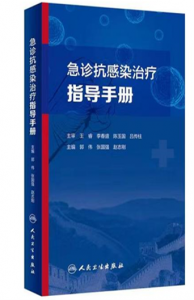Professional Insights: Navigating Optimal Diagnosis and Treatment of Infectious Diseases in the Emergency Department

Professor Guo Wei
Beijing Hospital of Traditional Chinese Medicine, Capital Medical University
- Deputy Director of Capital Medical University Beijing Hospital of Traditional Chinese Medicine, Master’s Supervisor, Deputy Director of the Department of Emergency Medicine, Capital Medical University.
- Published a total of 92 papers including 16 SCI papers. Authored 6 articles including the “Expert Consensus on the Application of Procalcitonin in Classified Management of Adult Lower Respiratory Tract Infectious Diseases”, “Chinese Expert Consensus on Stroke-Related Pneumonia, 2010 and 2019 Editions”, and “Expert Consensus on the Clinical Application of Bronchoscopy in Critical Care”. Chief editor/translator of 9 publications including the “Emergency Department Matters: Images and True Stories”, “Practical Handbook for Emergency Bronchoscopy Operations”, “Process Diagrams of Emergency Medicine Technical Operations”, and “Emergency Anti-Infective Treatment Guidebook”.
- Chairman of the Emergency Medicine Division, Chinese Geriatrics Society; Deputy Director of the Emergency Medicine Division, Beijing Medical Association; and Deputy Director of the Emergency Medicine Division, Chinese Stroke Society.
- Standing editorial committee member of “Clinical Emergency Medicine”; editorial committee member of “Chinese Journal of Emergency Medicine”, “Emergency Medicine in China”, and “International Geriatric Medicine”.
Introduction: Infectious diseases presenting in the emergency department are diverse and complex, often associated with an extremely high mortality rate. Effective prevention, detection and treatment is crucial.
Infectious diseases encompass illnesses caused by pathogenic microorganisms, such as bacteria, viruses, atypical pathogens, and fungi, which induce various clinical symptoms in the human body through diverse mechanisms. Despite significant advancements in prevention and treatment, infectious diseases continue to pose a significant burden with high morbidity and mortality rates.1 Therefore, the prevention and treatment of infectious diseases remain a top priority, requiring a multi-pronged approach and the adoption of new methods for tracking, prevention, diagnosis and treatment.
In this issue, “Medical Community” is pleased to invite Professor Guo Wei, Deputy Director of Beijing Hospital of Traditional Chinese Medicine, Capital Medical University, to discuss with us the strategies for optimizing the diagnosis and treatment of infectious diseases in the emergency department.
Key Considerations in Managing and Controlling Infectious Diseases: Navigating Pathogen Complexity
The emergency department, serving as the primary point of care for patients with infectious diseases, stands apart from other departments due to the often concealed, urgent and critical nature of patient conditions. Professor Guo Wei emphasized that it is essential to prioritize elderly patients, because their initial stages of diseases tends to be concealed and manifest with atypical symptoms. Even if they are experiencing respiratory tract infections, they may initially exhibit symptoms such as lethargy, reduced appetite, or fatigue. However, these conditions can quickly deteriorate, resulting in poor prognosis or even death.
Infectious diseases in the emergency department mainly involve respiratory tract infections, including the recent outbreaks of pathogens such as Mycoplasma pneumoniae and Streptococcus pneumoniae. In addition, abdominal and urinary tract infections caused by Enterobacteriaceae are also common. Furthermore, pathogens causing severe infections, such as Legionella and the drug-resistant Staphylococcus aureus, pose significant challenges.
Moreover, public awareness regarding infectious diseases should extend beyond bacterial infections, because viruses also warrant considerable attention. Due to their robust adaptability and mutability, viruses possess the potential to trigger new outbreaks in the future, leading to outcomes that are unpredictable. Therefore, in diagnosis and treatment, it is necessary to constantly bear in mind the varied nature of infectious diseases pathogens, and maintain a high level of vigilance towards infectious diseases.
The emergency department faces a myriad of pathogens and diverse patient symptoms, coupled with rapidly progressing conditions, which impose significant challenges and urgent work pressures on emergency doctors.
Addressing the challenges in diagnosis and treatment of infectious diseases, Professor Guo Wei emphasized the importance of effective collaboration between the emergency departments and fever clinics. Redirecting patients with suspected symptoms to fever clinics for diagnosis and treatment can minimize their contact with other patients in the emergency department, thereby reducing the risk of transmission. However, it remains challenging to achieve 100% redirection in practice, so prevention remains the first line of defense.
In terms of preventive management in the emergency department, simple and effective measures can be taken. For instance, patients exhibiting respiratory symptoms, except those at risk of experiencing a drop in blood oxygen levels or developing breathing difficulties, can be requested to wear face masks. Additionally, strict adherence to mask-wearing among healthcare workers is essential for self-protection.
To prevent the incidence of severe infections, special attention needs to be placed on the prevention and control of drug-resistant bacteria, especially in the case of nosocomial infections. Professor Guo Wei pointed out that nosocomial infections exhibit higher rates of drug-resistant bacteria than community infections. Additionally some patients may be suffering from underlying diseases, resulting in poor prognosis. Mortality rates for patients with nosocomial infections also surpass those with community-acquired infections.2 Therefore, Professor Guo Wei suggested that hospital infection prevention and control departments should take proactive steps to implement preventive measures, such as isolating patients with drug-resistant bacteria infections and strengthening hand hygiene practices among medical staff to prevent pathogens transmission.
In terms of management of hospitalized patients, medical staffs must be diligent in their respective roles. For example, in the case of patients with stroke, it is necessary to maintain the correct posture: a supine position with a 30-45 degree elevated headrest to prevent gastric reflux and aspiration, thereby reducing the risk of pneumonia. As for catheters such as urinary catheters, tracheal intubations and intravenous catheters, timely removal is crucial to minimize their duration in the body and hence the risk of associated infections.
Precise Treatment and Advancement in Detection Technology
Professor Guo Wei suggested proactive etiological testing for patients with severe and complicated infections, particularly in elderly, pregnant women and children. Advancements in science and technology, accelerated by the COVID-19 pandemic, have expanded the array of pathogen detection methods, ranging from antigen and antibody assays to genetic testing, providing more options to identify the source of infection.
Professor Guo Wei advocate the use of Point-of-Care Testing (POCT) methods. POCT refers to the simple testing performed by a doctor or nurse at the patient’s bedside, which speeds up the pathogen detection process. However, this technology may be more commonly found in fever clinics, while promoting its use in emergency departments will still require active coordination of hospital resources.
Professor Guo Wei pointed out that the ideal treatment strategy entails promptly identifying the pathogen and administering medication in a targeted approach. In addition, some adjunctive methods such as inflammatory marker testing can aid in ascertaining potential pathogens and monitoring the patient’s treatment progression. This facilitates timely adjustments of the medication, minimizes the duration of exposure to anti-infective drugs, and delay the onset of drug resistance.
In tackling infectious diseases, the optimal approach involves targeted antibacterial treatment guided by pathogen detection results. However, emergency patients are often presented with acute and rapidly progressing conditions, with the pathogen often unidentified in the early stages of the disease. Therefore, early antibiotic treatment typically relies on empirical, probabilistic approaches aimed at addressing possible pathogens, with a focus on bacteria known to cause severe infection.3
The emergence of quinolones has significantly enhanced antibacterial treatment. Quinolone antibacterial drugs, such as sitafloxacin, are among the most widely prescribed broad-spectrum antibacterial drugs, and exhibit potent antibacterial activity against both Gram-negative and Gram-positive bacteria.4 Professor Guo Wei also highlighted the widespread use of quinolone antibacterial drugs in emergency departments due to their broad antibacterial spectrum and good bactericidal effect.
However, to prevent the development of drug resistance, doctors must exercise careful judgments in drug utilization and avoid indiscriminate use, particularly among young doctors. Professor Guo Wei suggested that young doctors engage in continuous learning and training through literature review, participation in academic conferences, medical education and other channels to accumulate experience in combating infections with pharmaceutical interventions.
Therefore, in pursuit of providing better clinical guidance for the diagnosis and treatment of emergency infectious diseases, Professor Guo Wei convened experts from emergency departments, infectious diseases, microbiology and pharmacy from across the country in 2020 to develop the “Emergency Anti-Infective Treatment Guidebook” (pictured below). The guidebook includes detailed content on multiple aspects, including pharmacology, microbiology, common infectious diseases of various systems encountered in emergency departments, and the management of multi-drug-resistant bacterial infections, presented in the format of a pocket-sized book. Professor Guo Wei expressed his commitment to closely monitor the developments in infectious diseases and outlined plans to update the publication periodically, striving to remain at the forefront of the latest advancements in diagnosis and treatment of infectious diseases.

Image: Emergency Anti-Infective Treatment Guidebook
Conclusion
Infectious diseases encountered by the emergency department are diverse and complex, with patient conditions often advancing rapidly. In emergency scenarios, quinolone antibacterial drugs are valuable options to emergency doctors for empirical treatment, given their broad antibacterial spectrum and effective antibacterial properties. Nevertheless, when circumstances permit, doctors must employ a comprehensive strategy encompassing both offense and defense, as well as targeted treatment, to achieve optimal outcomes in diagnosis and treatment.
References:
1. Standing up to infectious disease [J]. Nat Microbiol, 2019, 4(1): 1.
2. Xia J, Gao J, Tang W. Nosocomial infection and its molecular mechanisms of antibiotic resistance [J]. Biosci Trends, 2016, 10(1): 14-21.
3. Garin N, Marti C, Skali Lami A, et al. Atypical Pathogens in Adult Community-Acquired Pneumonia and Implications for Empiric Antibiotic Treatment: A Narrative Review [J]. Microorganisms, 2022, 10(12).
4. Tang K, Zhao H. Quinolone Antibiotics: Resistance and Therapy [J]. Infect Drug Resist, 2023, 16: 811-20.










